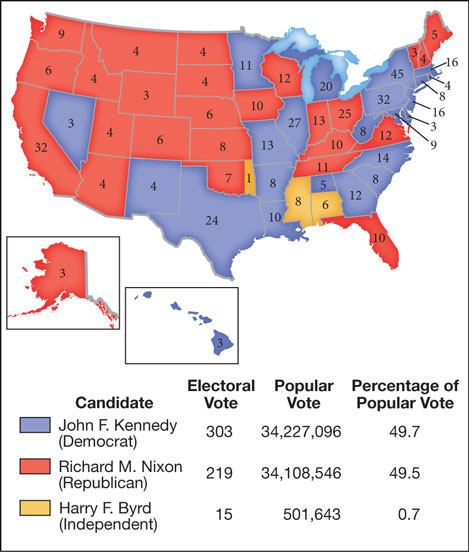The Election of 1960
Even after serving two terms in office, Eisenhower remained popular. However, he could not run for a third term, barred by the Twenty-second Amendment (1951), and Vice President Richard M. Nixon ran as the Republican candidate for president in 1960. Unlike Eisenhower, Nixon was not universally liked or respected. His reputation for unsavory political combat drew the scorn of Democrats, especially liberals. Moreover, Nixon had to fend off charges that Republicans, as embodied in the seventy-year-old Eisenhower, were out-of-date and out of new ideas.
Running as the Democratic candidate for president in 1960, Senator John F. Kennedy of Massachusetts promised to instill renewed “vigor” in the White House and get the country moving again. Yet Kennedy did not differ much from his Republican rival on domestic and foreign policy issues. While Kennedy employed a rhetoric of high-minded change, he had not compiled a distinguished or courageous record in the Senate. Moreover, his family’s fortune had paved the way for his political career, and he had earned a well-justified reputation in Washington as a playboy and womanizer.
The outcome of the 1960 election turned on several factors. The country was experiencing a slight economic recession, reviving memories in older voters of the Great Depression, which had begun with the Republican Herbert Hoover in power. In addition, presidential candidates faced off on television for the first time, participating in four televised debates. TV emphasized visual style and presentation. In the first debate, with Nixon having just recovered from a stay in the hospital and looking haggard, Kennedy convinced a majority of viewers that he possessed the presidential bearing for the job. Nixon performed better in the next three debates, but the damage had been done. Still, Kennedy had to overcome considerable religious prejudice to win the election. No Catholic had ever won the presidency, and the prejudices of Protestants, especially in the South, threatened to divert critical votes from Kennedy’s Democratic base. While many southern Democrats did support Nixon, Kennedy balanced out these defections by gaining votes from the nation’s Catholics, especially in northern states rich in electoral votes (Map 25.2).

Race also exerted a critical influence. Nixon and Kennedy had similar records on civil rights, and if anything, Nixon’s was slightly stronger. However, on October 19, 1960, when Atlanta police arrested Martin Luther King Jr. for participating in a restaurant sit-in, Kennedy sprang to his defense, whereas Nixon kept his distance. Kennedy telephoned the civil rights leader’s wife to offer his sympathy and used his influence to get King released from jail. As a result, King’s father, a Protestant minister who had intended to vote against the Catholic Kennedy, now endorsed the Democrat. In addition to the elder King, Kennedy won back for Democrats 7 percent of black voters who had supported Eisenhower in 1956. Kennedy triumphed by a margin of less than 1 percent of the popular vote, underscoring the importance of the African American electorate.
REVIEW & RELATE
Why did Eisenhower adopt a moderate domestic agenda? What were his most notable domestic accomplishments and failures?
Why did Kennedy win the 1960 presidential election?
Exploring American HistoriesPrinted Page 850
Exploring American Histories Value EditionPrinted Page 628
Chapter Timeline